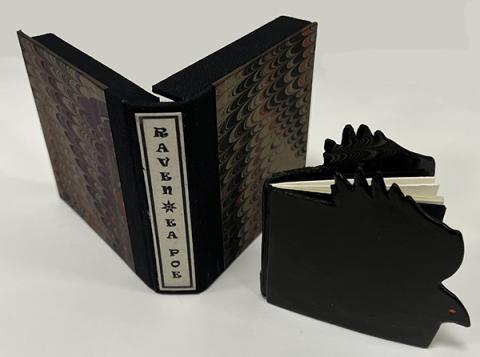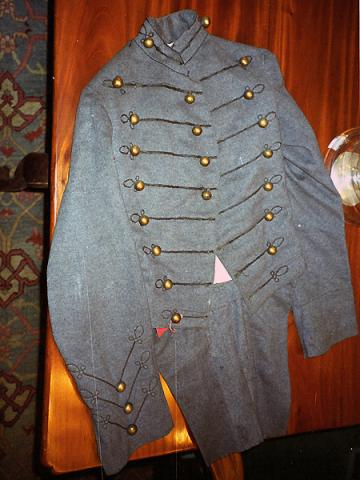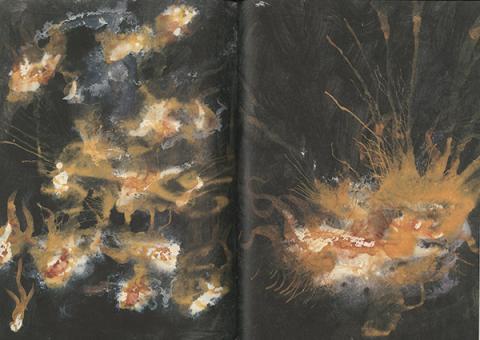December 12, 2023
During my time this semester as a student worker with the University Art Collection in the Booth Family Center for Special Collections, I have been afforded countless opportunities to learn about history, art, music, and more through the materials available in Booth’s collections. Some of that learning takes place directly through the work I do, but as a student employee, I have also had the opportunity to attend some of the lectures the Special Collections staff offer in Booth’s classroom for classes visiting from across campus.
I am so grateful to have had the chance to participate in these classes and see the wonderful materials Booth’s curators selected and brought out from the collections; these classes supplemented my own course learning and satisfied my curiosity. They also inspired me to share about the Special Collections. I told friends, family, and professors about the wonderful materials I was able to interact with during the classes, and shared about the art and artifacts that the Booth Collection holds. Now, I have been offered this platform to share about some of my favorite materials more broadly.
The first class I attended in Booth was Art of the Book. This class, which supplemented Georgetown University’s course by the same name taught by Professor Scip Barnhart, is all about how art and books interact. The Rare Books and Art Collection curators collaborated to put together a selection of books for the students to peruse and to study. My favorite of these books was a miniature version of The Raven.

At a size that could fit into, and even potentially get lost in, a pocket, Jan and Jarmilla Sobota’s The Raven depiction stood out to me immediately when I saw it. Shaped like a raven, with a red eye and all, this artist’s book fascinated me for its simplicity in bringing Edgar Allen Poe’s literary work off the page. When I read the stanzas within, my hands rested upon the leather feathers, and the work gained new meaning. Though all of the other materials in the lecture were also interesting, and many of them were very intricate, the straightforward yet thought-provoking design of this artist’s book is what remained in my mind from that day forward, and it was the book I most wanted to share about with my friends and family.
A couple of months later, I had an opportunity to attend another lecture in the Booth Center. Not only did I attend Professor Susan Pinkard’s Material Culture visit, I also helped to set up the numerous artifacts included. While doing so, my supervisors and I discovered what may be a rather humorous fact about a famous historical figure. The University Art Collection houses more than just prints, paintings, and sculptures: the Collection also includes historical artifacts such as the one pictured below:, General Custer’s West Point jacket.

While setting up the classroom to display all of the objects, we attempted to place General Custer’s jacket onto a mannequin. However, the class did not see General Custer’s jacket displayed on a mannequin. The reason? According to the dimensions of this jacket, the width of General Custer’s shoulders was just 14 inches. The jacket itself could not fit on our modern mannequin, which more closely resembles a modern American man’s shoulder width of around 16 inches. The artifact itself fascinated me, but the struggle I had trying to get it onto a mannequin, then the realization of how people’s bodies change throughout history added depth and meaning to it. In the context of a Material Culture class, the struggle to adapt modern display tools to historical artifacts is significant as it shows how our material culture shifts throughout time as society, health, and people develop.
The final class I was able to attend this semester was on Dante, with Professor Francesco Ciabattoni. The Rare Books and Art Collection curators collaborated to put together what I think was my favorite class repertoire of the semester. In particular, I found myself fascinated by an illustrated version of Dante’s Divine Comedy completed by Spanish artist Miquel Barceloin 2003. Alongside Dante’s writing, he supplemented with experimental watercolor images.

The piece that stood out most to me accompanies Dante’s 27th Canto in Purgatorio. It depicts the fires of Hell, but it also conveys the intimacy of the Canto which refers to the love of Pyramus and Thisbe and which emphasizes Dante’s own connection with Beatrice. To me, this particular page is not only meaningfully connected to the text, but the emotions which it awakens add depth to the text and create a greater connection between the reader and Dante’s emotions.
One of the most valuable parts of my time at the Booth Center for Special Collections has been to help gather materials for, set up, and attend these sessions for visiting classes. I have learned incredible information both from the Booth staff and from the professors leading the classes, and it has offered me, like the students enrolled in the courses, an opportunity to add real-world meaning and context to my studies. As I continue here, I hope to maintain my connection to the Booth community and to all the wonderful knowledge that lives up here on Lau 5.
--Elizabeth Koenck (SFS'27)
